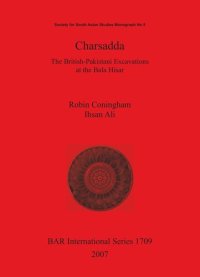
Ebook: Charsadda. The British-Pakistani Excavations at the Bala Hisar
Author: Robin Coningham Ihsan Ali
- Series: BAR British Archaeological Reports International Series 1709
- Year: 2007
- Publisher: BAR Publishing
- Language: English
- pdf
The Bala Hisar of Charsadda is a 23m high mound covering an area of some 25 hectares close to the confluence of the Swat and Kabul rivers in North West Frontier Province's Vale of Peshawa. Astride one of the arteries of the Silk Road, the uttarapatha, the mountain passes to its north and west link south Asia with central and western Asia. Strewn with thousands of ceramic sherds, cobbles and brickbats, the Bala Hisar was identified in 1863 as the city of Pushkalavati, one of the ancient capitals of Gandhar. Although not as formally investigated as Taxila to its south-east, it has been subject to antiquarian and archaeological interest for over 100 years on account of its historical links with the Achaemenid Empire and Alexander the Great. The focus of this research may have changed significantly over time, mirroring broader methodological and theoretical changes, but all researchers have attempted to identify when this great tell site was founded and occupied, and whether there is evidence of Alexander's siege of the site. These issues are not merely of interest to ancient historians but are of great interest to archaeologists of both southern and western Asia as the origins of South Asia second urbanisation are also under scrutiny, in Sir Mortimer Wheeler's words 'The outstanding importance of Charsadda lies in its earlier phases, when it was a metropolitan centre of Asiatic trade and meeting-place of oriental and occidental cultures'. Indeed, most archaeologists would agree that the Bala Hisar of Charsadda and Taxila are amongst the earliest cities that emerged during the subcontinent's second urbanization.